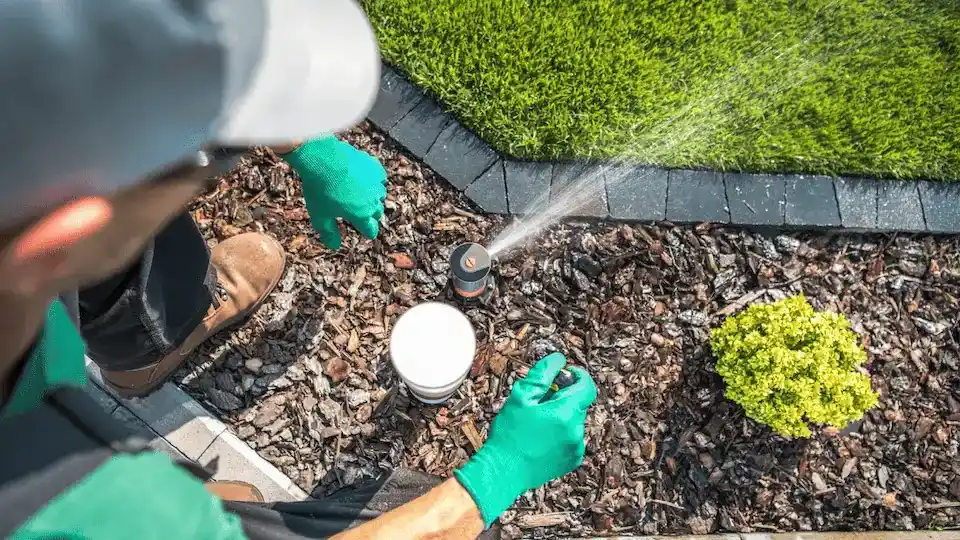Prepare For Winter: A Step-By-Step Guide to Winterizing Irrigation Systems to Prevent Damage

As winter approaches in Wake Forest, North Carolina, the breathtaking landscapes that Turf TitanZ has meticulously crafted for our clients face a new set of challenges. While the onset of winter brings with it a picturesque blanket of snow, it also poses a significant threat to your irrigation system. Neglecting to prepare your irrigation system for the harsh winter months can result in costly damage and extensive repairs come spring.
Our residential landscaping professionals understand the importance of safeguarding your landscaping investment, which is why we’ve prepared this step-by-step guide to winterizing irrigation systems. Join us as we walk you through the essential steps and tips to ensure that your irrigation system remains in optimal condition during the winter freeze.
The Importance of Winterizing Irrigation Systems
When winter arrives in the Tar Heel state, the risk of freezing temperatures can wreak havoc on your irrigation system. Unlike some milder regions, where irrigation systems may operate year-round, Wake Forest’s colder climate necessitates a proactive approach to protect your investment. Winterization is not merely an optional chore; it is an essential task to ensure the longevity and functionality of your irrigation system with winter landscaping practices.
Freezing Damage
When water remains within the sprinkler system during freezing temperatures, it can expand and cause PVC piping to crack or burst. This can result in extensive water damage to your property and costly repairs.
Component Failures
Cold temperatures can cause various components within the irrigation system, such as the manual drain valve, stop and waste valve, backflow device, and pumps to malfunction or break. Replacing these components of sprinkler systems can be expensive and time-consuming.
Inefficient Spring Startup
Neglected irrigation systems may struggle to function correctly when the warmer months return. This inefficiency can lead to overwatering or underwatering, potentially harming your plants and landscape.
Water Wastage
A malfunctioning irrigation system can unintentionally waste water during the winter months, increasing your utility bills and harming the environment.
Landscape Damage
Perhaps the most significant consequence is the potential harm to your carefully nurtured landscape. The very essence of your property’s beauty and charm may be compromised due to the failure to winterize your sprinkler system.
Step-by-Step Sprinkler System Winterization Process
As the winter season approaches, taking proactive steps to winterize your irrigation system becomes paramount in protecting your landscape investment. From shutting off the water supply to properly insulating vulnerable components, each step is vital in ensuring your system’s pipes and other components remain in optimal condition throughout the winter months.
Step 1: Shutting off the Water Supply
Begin by locating the main water shutoff valve for your irrigation system. This valve is typically located near the point where your irrigation system connects to the main water supply. Turning off this valve will prevent any additional water from entering the system.
Once you’ve found the main shutoff valve, turn it off by rotating it clockwise. This action will cut off the water supply to your sprinkler system, ensuring that no water flows through the pipes during the winter months. Make sure to label or mark this main valve for easy identification in the future.
Step 2: Drain the System
After shutting off the water supply, open any drain valves or low points in your irrigation system. This will allow any remaining water to escape. Ensure that all water is drained from these points, as even a small amount of residual water can cause damage when it freezes.
To thoroughly remove any remaining water from the irrigation lines, use an air compressor with a suitable attachment. Slowly introduce compressed air into the system, starting from the farthest end and working your way back. The air pressure will force out any remaining water, leaving the pipes dry and resistant to freezing.
Step 3: Inspect and Repair
Carefully inspect all components of your irrigation system, including pipes, valves, and fittings. Look for any signs of damage, wear, or corrosion. Identifying issues at this stage is crucial for preventing further damage. If you discover damaged or worn-out components, take immediate action to replace or repair them. Prompt attention to these issues can save you from more extensive and costly repairs in the future.
Step 4: Adjust Controller Settings
Access your irrigation system’s controller and adjust its settings for the winter season. Most controllers have a “rain mode” or “off mode” specifically designed for winterization. This setting ensures that the system won’t activate during freezing temperatures.
Double-check that the controller settings are correctly adjusted to prevent the system from turning on during cold weather. This step is crucial in avoiding potential damage from freezing water within the pipes.
Step 5: Protect Vulnerable Areas
Wrap above-ground pipes with pipe insulation or heat tape to provide an extra layer of protection against freezing temperatures. Insulation helps maintain a stable temperature and prevents pipes from freezing and bursting.
Protect valve boxes, which often contain important components, by covering them with insulated blankets or specialized valve box covers. This insulation will shield the valves and connections from the cold.
For any exposed irrigation components in your landscaping, such as above-ground valves or backflow preventers, apply a layer of mulch or protective covering. This additional insulation will help safeguard these vulnerable areas from freezing temperatures and potential damage.
Benefits of Irrigation System Winterization
As the temperature drops and frost blankets the region, taking steps to protect your irrigation system becomes a necessity. Winterizing your irrigation system isn’t just a seasonal chore; it’s a proactive measure that can save you time, money, and the hassle of dealing with costly repairs in the spring.
Some of the many benefits of winterizing irrigation system practices include:
Prevent Freezing Damage
Prolonged System Lifespan
Efficient Spring Startup for Lawn Care
Cost Savings
Environmental Responsibility
Preservation of Landscape Beauty
Peace of Mind
Compliance with Local Regulations

Contact Our Experts in Winterizing Irrigation Systems in NC Today
Don’t leave the fate of your irrigation system and landscape to chance this winter. Take the proactive step of safeguarding your investment by enlisting the expertise of Turf TitanZ. Our seasoned Wake County landscaping experts specialize in the art of winterizing irrigation systems, ensuring that your property remains protected from the harsh winter elements.
Contact us today to schedule your winterization service. Our dedicated team is ready to assess your needs, answer your questions, and tailor a plan for your landscape and sprinkler system that suits your specific requirements.
Don’t wait until the first frost; act now to ensure a vibrant and flourishing landscape in the seasons to come. Give us a call at (919) 562-0771 or fill out the form below to get started.
Contact Form
We would love to hear from you! Please fill out this form and we will get back to you shortly.
